|
Introduction
This is Part 1 of a 3-Part white paper series which provides an overview of the latest automation technologies available for high volume full pallet distribution storage and retrieval operations such as in the Fast-Moving Consumer Goods (FMCG) industry. Highly effective automation technologies are available from global material handling vendors and our expectation is that these technologies will increasingly be deployed on North American soil. This concludes Part 1 of our white paper on automation for distribution in the food and beverage industry. Part 2 (click here) and Part 3 (click here) discuss the latest technologies for ASRS, pallet sortation and automated truck loading systems.
The high level of competition in the automated material handling market place is continuously spawning new innovations that ultimately benefit the customer. The intent of this article is to explain key concepts for automated solutions to support high volume distribution operations. This white paper focuses on full pallet operations but there are also many innovative solutions available to automate full case picking and palletizing operations. MWPVL International has been actively involved in designing these facilities and evaluating vendor solutions and our goal is to share our learnings. Any opinions expressed within this article are strictly those of the author.
Background
Production plants that produce beer, bottled water, sodas, fruit juices, dairy products, etc. typically have multiple filling lines that output pallets of finished goods merchandise at speeds as fast as 1 pallet every 30 seconds. These pallets need to be horizontally transferred away from the production lines and stored into a warehouse as quickly and efficiently as possibly. Similarly, products need to be retrieved from storage for continuous order fulfillment with minimal lead times and fast rates of throughput. .
The requirement to move, store and retrieve a high volume of full pallets quickly and efficiently through a distribution facility using a minimal building footprint is a perfect fit for automated material handling systems. The automation solutions that are available on the market today, particularly in Europe, are quite simply unprecedented. Within the body of this white paper, we share our insight as to the differences between these solutions and why one might consider one type of technology versus another. It is important to keep in mind that these generalizations are not intended to be hard and fast rules, rather they are intended as discussion points that hopefully help the reader gain insight into the world of automated distribution.
Part 1 of this white paper will review the concepts listed below:
- Pallet Transfer Solutions (Production to Storage)
- Vertical Pallet Transfer Solutions
- Horizontal Pallet Conveyors
- Overhead Monorail Systems
- Inverted Monorail Systems
- Automated / Laser Guided Vehicles
Part 2 (click here) of this white paper reviews the concepts listed below:
- High Bay Warehouse Automated Storage and Retrieval Systems (ASRS)
- Single-Mast Single-Pallet ASRS
- Single-Mast Dual-Pallet ASRS
- Aisle-Changing ASRS
- Dual-Mast Dual-Pallet ASRS
- ASRS with Satellite Carrier
- Shuttle Cart Technology
Part 3 (click here) of this white paper reviews the concepts listed below:
- Shipping Solutions
- Inverted Monorail
- Overhead Monorail
- Conveyor Systems with Transfer Cars
- Automated Truck Loading Systems
- AGVs
- ATLS
PART 1: Pallet Transfer Solutions (Production to Storage)
1.(a) Vertical Pallet Transfer Solutions
In the typical food/beverage production operation, there are multiple production lines (i.e. filling lines) that output pallets of finished goods. At the end of each production line, there is usually an automated pallet stretch wrapping machine to wrap pallets coming out of production. Pallets are then labeled with a unique license plate or bar coded identification label. From here these pallets need to be quickly transferred away from production to the storage warehouse which may be in an adjacent section of the complex or in a separate building altogether. For the purposes of this article, we will assume that the warehouse is in the same complex as the production operation.
For the purpose of moving pallets from production to the storage warehouse, It is quite common to establish an elevated horizontal pallet transfer system that resides on a mezzanine structure. The most common scenario is to have one pallet elevator per production line with single or dual unit load capability depending on the line output requirements.
- Elevated horizontal transfer systems are required because the floor area may need to be kept free of obstructions for fire escape reasons. The floor area is also needed to support the transfer of empty pallets, raw materials and packaging supplies to the filling lines during the production process. Raw materials, packaging supplies and empty pallets are often transferred to production lines via floor-level laser guided vehicles (LGV) and/or forklift Trucks (FLT).
- If there is a need to elevate pallets to a mezzanine then vertical lift elevators can be deployed to transfer pallets one at a time or in pallet pairs. The typical scenario is that a pallet conveyor feeds pallets to the elevator which then elevates the unit loads up to the mezzanine.
- Pallets can be vertically transferred to a mezzanine via a pallet elevator in about 8 - 12 seconds (assuming a mezzanine elevated to a height of 18’ (5.5 m). A single load elevator can move between 84 to 122 pallets per hour and a double load elevator can move between 132 to 186 pallets per hour. Since double pallet elevators are more expensive, they are typically deployed for production lines that have higher volumes of output.
Horizontal Pallet Transfer Solutions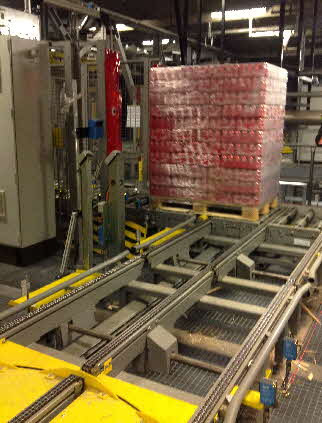
Multiple options exist to move pallets horizontally away from production to warehouse storage. Since the layout constraints of each facility are different, the choice of horizontal transfer technology needs to be determined within the context of the facility layout and the required pallet throughput volume. There are definite trade-offs that need to be considered with each type of technology.
1.(b) Pallet Conveyor Systems
- Types of pallet conveyor:
- Powered pallet conveyor systems for horizontal pallet transfer are the most commonly deployed transfer systems in production facilities, mainly because this technology has been around the longest. These systems may be comprised of a combination of chain-driven live roller conveyor, chain-strand conveyor, air-chain accumulation conveyor, transfer cars, right angle transfer units, roller tables and other types of conveyor equipment.
- For long horizontal transfer runs where pallets are being buffered between production and a high bay storage warehouse, the use of air chain pallet accumulation conveyor can be deployed to allow pallets to queue with frequent starts and stops. This enables multiple production lines to feed into the conveyor transfer line similar to entrance ramps feeding into a highway. Air chain pallet conveyor can be designed to have a continuous drive chain in the center with wheels on the sides. It can also be designed to have a centered drive chain that powers rollers on either side. The benefit of this type of equipment is that a single drive motor can power up to 100’ (30.5 m) of conveyor. As well, this type of conveyor can handle a wide variety of pallets in any orientation.
- For a smooth continuous transfer of pallets, the strand chain conveyor is designed to transport pallets with bottom boards that are perpendicular to the direction of transport. Pallets must have bottom boards/blocks that rest on the chain strands. The chains propel the pallet forward such that the pallet does not move on the chain. The benefit of strand chain conveyor is that it provides a smooth, quiet ride with continuous and reversible flow. Chain conveyors are usually installed in 2-strand or 3-strand configurations with single or double chain strands. Much of this depends on the types and weights of pallets being transferred and the need to support the pallet from below to prevent any type of stress that may bend the pallet.
- For horizontal transfer runs where pallets are being moved between point A to point B in a continuous movement, live chain-driven roller conveyors can also be used. These conveyors provide the maximum flexibility to transport pallets with very few and/or extremely narrow runners, as well as a wide variety of sizes and shapes of pallet loads. Depending on the center to center dimension of the conveyor rollers, the ride may not be smooth, so typically the rollers are spaced between 3” to 6” (76 to 152 mm) apart. The typical configuration is to have a single drive chain power the rollers that are connected through sprockets.
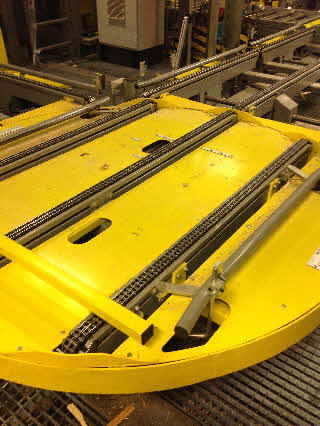
- Since pallet conveyors are linear, to change direction, it is necessary to use mechanical right angle transfer units (3-way and/or 4-way) whereby rollers and strand chains are used in conjunction to transfer pallets 90 degrees at key junctions. These can be highway intersections where pallets need to turn left or right; or straight through the junction. A drive motor will raise the chains above the rollers to lift the pallet off the roller. The chains then move the pallet in a perpendicular direction.
- Rotating conveyor turntables are used to change the orientation of a pallet such that it can be transferred on a different dimension. For example, a 40” x 48” (1.0m x 1.2m) pallet that is being transferred on the 40” (1.0m) face may need to be rotated to so that it can be transferred on the 48” (1.2m) face in order to exchange the pallet with another material handling system. The rotating conveyor table serves exactly this purpose. Larger rotating tables can spin up to 4 pallets at a time.
- Transfer cars are mechanical transfer carts that can move up to 4 pallets at a time from one conveyor to another conveyor. The transfer car stops at one conveyor line to pick up one or more unit loads and then the transfer car moves the unit loads horizontally so that they can be dropped off at another conveyor line. Transfer cars are generally powered by bus bar or cable track and they provide an economical means of transferring pallets from one conveyor system to another. As an example, we often see transfer cars deployed on the shipping dock to move pallets output from a high bay warehouse to their designated shipping conveyor lanes.
- Gravity pallet conveyors are often deployed on the shipping dock to serve as staging lanes to buffer truck loads on the dock in advance of loading. Pallets are typically loaded from the rear and an angled decline is used to slowly transfer the pallet to the front of the staging lane.
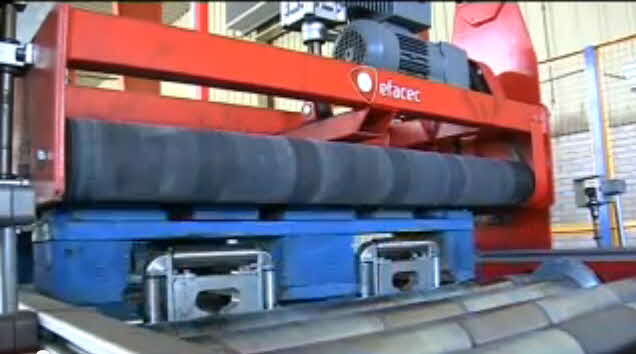
- When a manufacturing operation receives wooden pallets that need to be quality inspected before being released to the production lines, it is important to consider pallet inspection stations that automatically assess the quality of empty pallets arriving from the inbound receiving dock. Pallets are usually received as vertical stacks of 8 - 10 boards that are placed onto a live roller conveyor. A side clamping mechanism holds the stack and releases the bottom pallet one at a time to the roller conveyor. Pallets are then conveyed forward where they are placed under a pressured roller bar to fix loose boards. At the same time, a pair of pop-up devices seek out and automatically remove any loose nails.
- Other pallet conveyor components that will likely need to be considered as part of a pallet conveyor system include a pallet squaring station for incoming pallets of inventory. This equipment automatically squares and centers incoming raw material and packaging supply unit loads before being released to storage. Similarly, a pallet profile station is used to verify the exact dimensions of an incoming unit load prior to release to an AS/RS system. The pallet profile is verified with multiple photo eyes to ensure conformance to system requirements. In the event that incoming pallets cannot be supported by the ASRS system (e.g. incompatible pallet), pallet inverters can be used to insert slave pallets under the incoming load. Lastly, the conveyor system will likely need to be equipped with interface stations where pallets are transferred from the conveyor system to a pallet jack, forklift, AGV or ASRS machine.
- Pallet Conveyor - Pros and Cons and Considerations
- First and foremost, it is important to say that a manufacturing plant that produces full pallets of product that are transferred to an automated distribution system will require some type of pallet conveyor systems to move materials. The question is not so much whether or not to use pallet conveyors because they are an essential component of any automated facility. The real question is what alternative systems exist that can cost effectively and reliably perform the material transfer function?
- One major benefit that a pallet conveyor system can provide is that it provides a buffer between the production lines and the warehouse storage system. For example, if the storage system is an automated high bay warehouse (HBW) with ASRS stacker cranes, then a buffer between production and the HBW may be important to have. This is because any downtime within the ASRS system does not immediately translate into a shutdown of the production lines. By having pallets accumulate within a buffer system, this protects the production operation from immediate disruption in the event of any downstream issues with automated storage systems.
- Pallet conveyor systems are generally considered to be a slow form of horizontal transport as compared to other available solutions. Standard horizontal transfer speeds generally range between 40 - 80 feet per minute (0.2 to 0.4 m/s) depending on the type of conveyor in use and the application. To put this into perspective, an adult can walk at an average speed of 275 feet per minute (1.4 m/s) so conveyors are relatively slow as compared to other available technologies. This is why pallet conveyors are often deployed when transfer distances are relatively short.
- While pallet conveyors provide a highly reliable transfer system, they are also subject to the weakest element of any automation system which is the quality of the wooden pallet and shrink-wrap “tails”. A main cause of problems within any automated warehouse are broken pallet boards and loose nails which can result in conveyors becoming jammed. Similarly, loose “tails” of shrink-wrap can be a nuisance because sensors detect the shrinkwrap as being a problem issue that requires operator intervention. Removing a jammed board or nail from a chain conveyor is not the end of the world but it does cause the shutdown of the line while the repair is happening.
- Pallet conveyor systems also require a fairly high degree of maintenance relative to other technologies available in the market place today. Chains need to be regularly oiled and inspected for tension.
- While a pallet conveyor system may provide a lower initial capital investment as compared to alternative technologies, the reality is that eventually a conveyor system needs to have a major overhaul. It is important to understand this when developing the economics for each alternative being assessed. It is not uncommon to require a major conveyor overhaul between years 7 - 10 following the start-up of a busy 3-shift production/distribution operation.
1.(c) Overhead Monorail Systems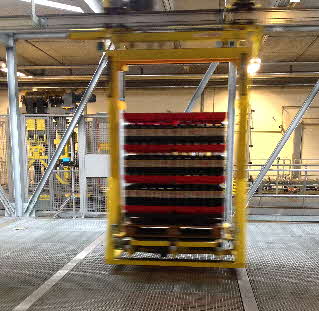
- Description of Overhead Monorail Systems:
- Overhead monorail systems can be designed to transfer pallets as single unit loads or in pallet pairs. Either way, the monorail trolley is supported by a closed-loop overhead rail that contains a bus bar to deliver power to the trolley. All trolleys are equipped with sensors to detect other trolleys on the line such that they never collide in transit. Think of a monorail as a closed-loop that transfers trolleys from points where they pick up pallets to points where they drop off pallets. The trolleys move independently of one another and can be staged to a buffer lane when not in use.
- Overhead monorail systems are generally (but not always) deployed for systems where long transfer distances are required. For example, if a production plant is constructed on one side of a road and the high bay warehouse is constructed on the other side of the road, then an enclosed bridge can be constructed to horizontally transfer pallets via monorail over the road. A good guideline is that travel distances in excess of 1,500 feet (457m) are suitable for overhead monorail applications.
- Monorails have been in use for decades in the automobile production industry where a car needs to be moved from station to station with a reliable and smooth acceleration and
 deceleration that is also safe for operators to work around. These systems are extremely reliable and the most common maintenance issue tends to be the basic need to replace worn out bar code labels installed along the bus bar track to identify the position of each trolley. Once it is up and running, a monorail system is a consistently reliable horizontal transfer technology that has a reputation for being a low maintenance system. If ever a monorail trolley needs to be repaired or maintained, the monorail loop is typically designed with a switch to allow the trolley to be navigated off of the main loop to a designated “maintenance lane”. The benefit of this approach is that the monorail system can continue to operate while a trolley is being repaired. This is an important consideration for operations where continuous uptime is critical. deceleration that is also safe for operators to work around. These systems are extremely reliable and the most common maintenance issue tends to be the basic need to replace worn out bar code labels installed along the bus bar track to identify the position of each trolley. Once it is up and running, a monorail system is a consistently reliable horizontal transfer technology that has a reputation for being a low maintenance system. If ever a monorail trolley needs to be repaired or maintained, the monorail loop is typically designed with a switch to allow the trolley to be navigated off of the main loop to a designated “maintenance lane”. The benefit of this approach is that the monorail system can continue to operate while a trolley is being repaired. This is an important consideration for operations where continuous uptime is critical.
- Overhead monorail - Pros and Cons and Considerations
- Monorails provide a high speed of horizontal transportation. Typical speeds for dual pallet transfer trolleys are in the range of 295 feet per minute (1.5 meters/second) when traveling in straight runs. The smooth acceleration and deceleration of this technology make it an ideal solution for moving pallets to the entry points of a high bay warehouse.
- Monorails need not be horizontally or vertically linear so there is a high degree of flexibility to design these systems with curves, inclines, declines, switches and junctions. Having said this it is generally a good idea to reduce the number of switches that move a trolley from one rail to another since this represents a potential weak point in the system.
- Overhead monorail systems provide clear floor access which implies that housecleaning is easier. It also means that pallets with leaking bottles do not corrode floor-mounted equipment or electronic equipment which can be a key consideration in the beverage industry.
- The main disadvantage of an overhead monorail system is that it requires a costly overhead substructure system to support the rails that carry the trolleys. Unlike an inverted monorail which is floor-mounted, the overhead monorail requires a structure from which hangs the weight of the trolleys and the pallets.
- Lastly, when considering an overhead monorail system, it will likely be important to simulate the system before investing in it, particularly if there is a high number of trolleys and pickup/drop-off points in the system. The reason for this is that trolleys will end up queuing in a chain as they approach potential bottleneck areas such as the entrance to the high bay warehouse where pallets are dropped off at the induction points for the ASRS system. If too many trolleys are in the system, then the speed of all trolleys is reduced which causes the entire system to run inefficiently. The intelligent design of an overhead monorail system really calls for a system simulation, especially as pallet transfer volumes increase.
1.(d) Inverted Monorail Systems
- Description of Inverted Monorail Systems:

- Inverted monorail systems can be designed to transfer pallets as single unit loads or in pallet pairs. Either way, the monorail cart resides on a floor-mounted closed-loop rail that contains a bus bar to deliver power to the cart. All carts are equipped with sensors to detect other carts on the rail such that they never collide in transit. Think of an inverted monorail as a closed-loop that transfers carts from points where they pick up pallets to points where they drop off pallets. The carts move independently of one another and are staged at one end of the loop when not in use.
- Inverted monorail systems are generally (but not always) deployed for systems where shorter transfer distances are required. For example, if pallets are being retrieved from a high bay warehouse for outbound sales orders then we often see inverted monorails used as the horizontal transfer system to move pallets to assigned shipping lanes. While inverted monorails can be used to move pallets from production for input into a high bay warehouse, this is a less common application unless the distances are short.
- Inverted monorail - Pros and Cons and Considerations
- Inverted monorails provide a very fast speed of horizontal transportation. The fastest speeds for dual pallet transfer carts are in the range of 590 feet per minute (3.0 meters/second). The smooth acceleration and deceleration of this technology make it an ideal solution for moving pallets between two points with quiet precision.
- Inverted monorails are generally linear closed loops so there is a less flexibility with system design as compared to overhead monorail systems. While junctions can be inserted into the loop to move carts on and off the loop, it is not common to do this. Typically, if a cart needs to be removed from the line because it requires repairs then the approach is to have an operator remove the cart using a forklift with a telescoping jib boom crane mechanism. Once repaired the cart is then reinserted to the line. Of course this process requires a line shutdown of about 15 minutes, so usually carts in need of repair are removed during a quiet time. In the mean, carts needing repairs can circulate around the loop and not be used.
- Inverted monorail systems are floor-mounted systems which implies that they need to be sealed off from operator access because the powered bus bar runs at floor level. To clean the area one must shut the system down. Pallets containing bottled liquids with leaks will of course impact the equipment since the cart resides below the pallet.
- In conclusion, inverted monorail systems are one of the fastest horizontal transfer technologies available on the market today and they are generally used for closed-loop transfer of pallets between two points along the loop. This technology can be used to transfer pallet pairs making it an ideal solution for high throughput environments where many pallets of the same SKU are being produced in one production run.
1.(e) Laser Guided Vehicles (LGV) and Automated Guided Vehicles (AGV)
- Description of Automated Guided Vehicles (AGV):

- An AGV is a mobile robot that follows markers or wires in the floor, or uses vision or laser technology to navigate. In short, an AGV is a computer-controlled, non-manned, electric powered vehicle that moves materials.
- When using laser technology, we refer to these machines as laser guided vehicles. Laser technology enables a wireless navigation system by mounting reflective tape on walls, building columns, and other fixed points. The laser is reflected off of the reflective tape and triangulation is used to automatically calculate the distance where the LGV is relative to the source of the reflective targets.
- There are four different type of AGVs:
- Fork (Outrigger/Straddle, Reach, Side Reach, Narrow Aisle, Counterbalance, Fork Over)
- Tow/Tugger
- Unit Load (Conveyor, Combination Lift & Conveyor, Standard, Lift)
- Custom
- For the purposes of this article we focus on battery powered unit load AGV machines.
- Historically, the first AGV appeared in 1953 and the first unit load AGV appeared in 1976. This equipment has been primarily deployed in manufacturing plants to move materials around a production facility. AGVs can transfer pallets as single unit loads or in pallet pairs. Today, AGVs can even be equipped with forklifts to store pallets into elevated vertical storage locations.
- For horizontal transfer purposes, AGVs are generally used (but not always) to move raw materials, packaging supplies, and empty pallets inbound to production lines. This equipment is expensive and travels at a relatively slow speed so the technology is not generally applied when high speed or high throughput is the application requirement.
- AGVs can be used to repetitively move raw materials, packaging supplies, empty pallets, and finished goods within or away from the production lines or to the input of a high bay warehouse. In general, AGVs are suitable for travel paths that exceed 150 feet (46m) and there are installations where the travel path exceeds 8,000 feet (2,440m). The vehicle can move along any desired path so there are no hard constraints in terms of how it is deployed. AGVs can also serve as a redundant backup system in the event that the main horizontal transfer system (e.g. overhead monorail) goes down.
- AGVs have been in use for decades within the manufacturing industry so the equipment is considered to be highly safe and reliable. The robotic machines are equipped with sensors so that they stop immediately upon detecting any type of obstruction.
- AGV / LGV - Pros and Cons and Considerations
- AGVs provide a relatively slow speed of horizontal transportation. The maximum speeds for dual pallet transfer vehicles are in the range of 394 feet per minute (2.0 meters/second) which is a little faster than a person can walk. On average unit load AGVs travel at speeds ranging between 100 to 300 feet per minute (0.5 to 0.76 m/s). The smooth acceleration and deceleration of this technology make it an ideal solution for moving unit loads with precision.
- AGVs can move pallets both horizontally and vertically so there is a high degree of flexibility to use this equipment in place of forklift trucks or pallet jacks, particularly if the navigation system is wireless. For example, in some plants, LGVs are used to move incoming pallets from the receiving doors to other areas of the operation. Some companies use LGVs to store pallets into vertical racking systems as an alternative to having a forklift driver perform this function. The flexibility to change or expand the travel path easily is one of the key benefits of AGV systems.
- AGVs represent a low risk solution because there is no single point of failure.
- AGV systems can be incrementally deployed as volume increases since there is no structural system required, as is the case with a monorail system. This is an important flexibility because these machines can be costly. Pricing for AGV unit load vehicles can range from $US 50,000 for a simple machine up to $500,000 for a complex machine. Overall, AGV technology can have a favorable cost/benefit ratio as compared to other material handling solutions.
- AGV systems provide clear floor access which implies that housecleaning is easier and provides for the ability to have fire escape corridors..
This concludes Part 1 of our white paper on automation for distribution in the food and beverage industry. In Part 2 (click here) we discuss the latest technologies for automated storage and retrieval systems. In Part 3 (click here) we discuss the latest technologies for pallet sortation and automated truck loading systems.
Marc Wulfraat is the President of MWPVL International Inc. He can be reached at +(1) (514) 482-3572 Extension 100 or by clicking here. MWPVL International designs automated distribution centers and automated material handling systems and can help your firm evaluate the most appropriate solutions for your manufacturing or distribution operation.
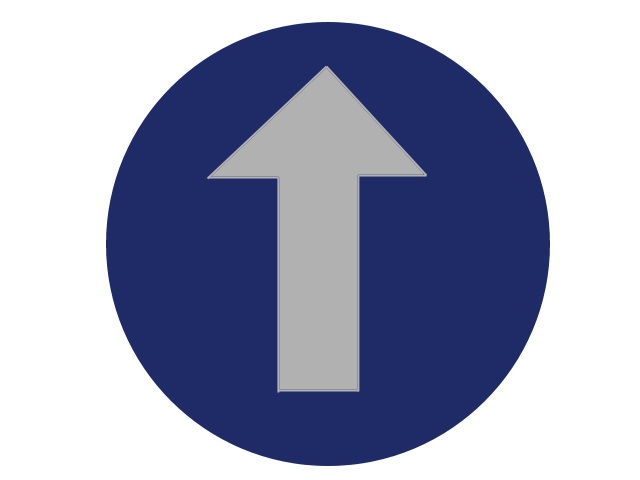
|
|